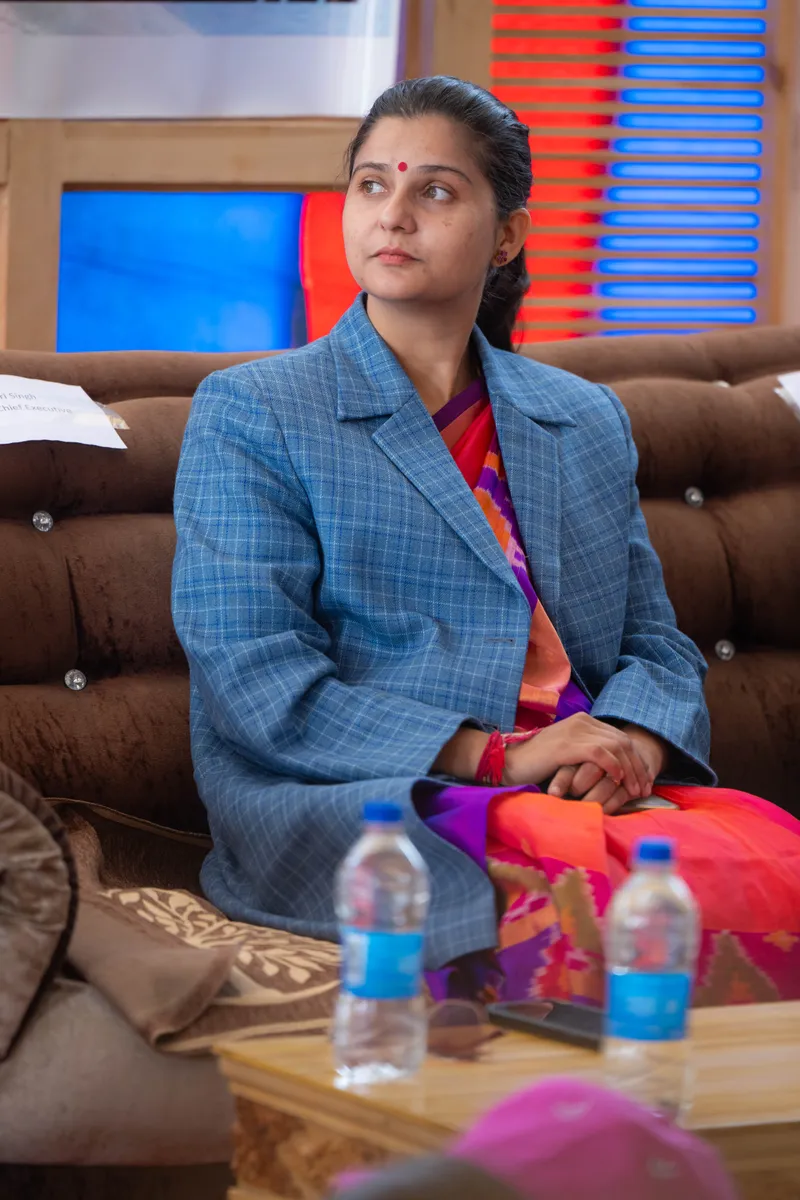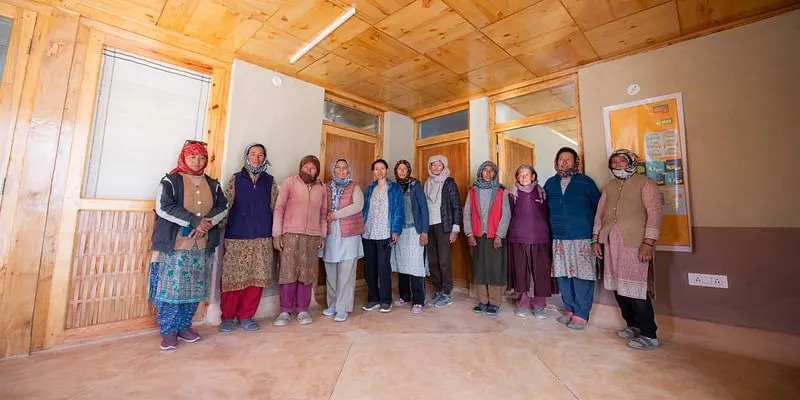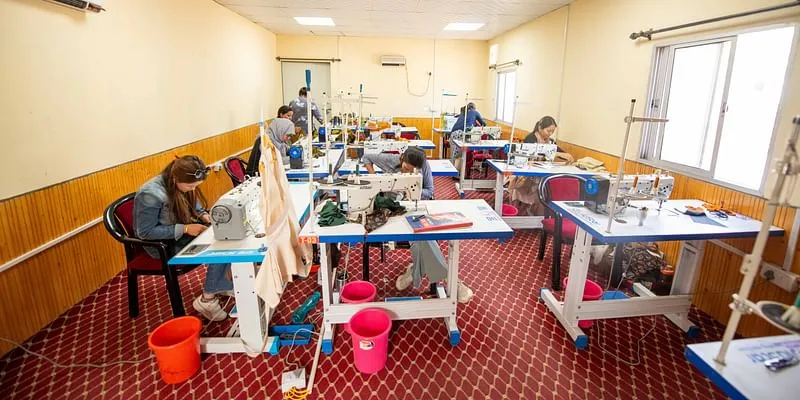How over 450 rural women are building a farm-to-fashion collective to bring Ladakhi pashmina to the world
Looms of Ladakh, a cooperative in Ladakh, is a fine example of the entrepreneurial zeal and persistence of over 450 women from 16 villages to showcase their pashmina to the world. Co-founder and director Abhilasha Bahuguna takes us through its journey.
In 2013, when Abhilasha Bahuguna was living in New Delhi, she heard her landlady bargaining furiously with some Kashmiri pashmina sellers. This incident sparked an immediate Facebook post in which she pondered over why the sector was unorganised, and if artisans could form a cooperative, they could benefit from it immensely and not succumb to bargaining.
Bahuguna had completed her education from Punjab University and the University of Tilburg in the Netherlands.

Abhilasha Bahuguna
Little did she know that, in just three years, she would be helping build a farm-to-fashion collective with over 450 women from 16 villages of Ladakh to build a herder-artisan-led luxury brand called Looms of Ladakh.
Enterprising spirit
But before that, it’s important to understand the role played by her husband G Prasanna, an IAS officer. When Prasanna was posted as deputy commissioner in Leh in 2015, he met a group of women from Chumur village who showed him some knitted pashmina socks.
“He was moved by their enterprising spirit in a difficult terrain like Ladakh. This prompted him to introduce a skill development initiative called Project Laksal in this area with 150 women. They were trained in knitting,” she recalls.
Unlike other states, there were no textile clusters for pashmina in Ladakh. Skills like knitting and weaving were transferred from one generation to another, mostly for personal use. It was not commercialised yet and was never sold for trade.
The pashmina goats are reared mainly by the Changpas, an ethnic group of pastoralist nomads at altitudes of 4,000-5,000m. But essentially, Ladakh remained a raw material economy while it was Kashmiri pashmina that was winning all the praise.
The skill development programme and design intervention got together women from different villages. They could now make products and sell them in different fairs and exhibitions or work for some local elites who sold upscale products in their own showrooms.
Bahuguna felt that a cooperative was the right way to push these women towards a larger purpose.
But there were hurdles right from the beginning.
“We registered the cooperative in 2017 with some local resistance. When we tried reaching out to the central government for funding, it was obstructed locally, and for four years, we ran Looms of Ladakh on our own,” she says.
When the women reached out to the Hill Development Council, they understood their vision and their plight, and gave them a space to rent at a subsidised rate.
The power of a cooperative

The power of a women's collective
However, Bahuguna says not being able to procure funding in the first four years was a blessing in disguise, because the women rallied together, got their own raw material, and started production in their own space and sold the finished products to local tourists.
“These 150 women stayed together in Leh for seven days and elected a management team from among them according to the bylaws. By the time we were into the third year, we faced challenges when some members began favouring their own villages. We rose above these, scouted new markets through exhibitions and fairs so that the women would have more exposure,” she adds.
The women also learned weaving and tailoring through programmes organised to diversify their skills. For example, Bahuguna also sent them to Usha Silai, a CSR programme for tailoring from the Usha Group.
In January 2018, Bahuguna was invited to IIM-Ahmedabad as a guest where she met Ermene Zildo Zegna, CEO of Italian luxury cashmere brand, Zegna. She now aspired that Looms of Ladakh become a global luxury brand. But for this, she understood that the skills, the embroidery, and the fabric had to be of high quality.
Funding, and after

Work in progress
By the fifth year, the women had become adept at running a cooperative, maintaining books, inventory, sales, and other functions. Bahuguna now decided it was time to reach out to investors to scale the project.
“Looms of Ladakh had become quite well known by then, but there was a notion that we didn’t like working with the government. We had always wanted to be autonomous without outside control and this sent a wrong signal. Nevertheless, we approached the NAB Foundation of NABARD who met us with a lot of warmth and sanctioned us Rs 1 crore in 2022,” Bahuguna says.
This was utilised to build Looms of Ladakh’s decentralised solar-heated studio in Chushul on the India-China border. Currently, it works on a hub-and-spoke model with the hub and central quality control atelier in Leh and decentralised spokes for manufacturing of garments in Chushul, Kargil, and Leh.
Many of Looms of Ladakh members are herders from the pastoralist community who supply the raw material. These are dehaired, carded, washed, and cleaned near Leh and then dyed according to standard colour codes. The pashmina is distributed to its members across villages in Kargil and Leh only for knitting and spinning, which is decentralised. The garment construction units at Leh, Kargil, and Chushul focus on manufacturing.
A weaver earns on an average Rs 15,000 a month, those who dye earn around Rs 15,000 and tailors can earn up to Rs 18,000 a month. But Bahuguna says the spinners and weavers earn less because they spend less time on the process and prefer to do construction work on roads.
Shakila Bano has been with Looms of Ladakh since its inception in 2017.
“As an office-bearer, I learned a lot about event management and showcase products at exhibitions and fairs. I became confident to speak to customers and sell the products. I was reelected and took up the post of a cashier, and learned ERP to manage finances,” she says.
Sonam who joined Looms of Ladakh a year ago says,
“After two months’ training, I started tailoring at Looms of Ladakh. It feels nice to be associated with such a brand. The work gives me a sense of independence."
Looms of Ladakh has a flagship store in Leh and is available at select Taj Hotels in Mumbai, Shimla, Delhi, and Bengaluru. They also sold at the Oculus Store at the World Trade Centre in New York and is looking at other international buyers.
It recently launched a social initiative label titled Perak for lower-end apparel that will give its members a sustained source of livelihood and build a cottage industry, becoming a stepping stone to expand their skills for luxury garments. They are looking at launching Perak on ecommerce platforms like Okhai, Amazon, and Myntra. Totally, Looms of Ladakh has around 25 SKUs.
The cooperative also received the Swavalamban Challenge Fund from Small Industries Development Bank of India (SIDBI), which is helping it build an ERP system to bring traceability and transparency to the production process and increase efficiency.
Looms of Ladakh is launching a capsule collection with Royal Enfield on November 15 in Mumbai featuring small knits and some tailored garments. It’s also working on R&D on yarn, and on pricing to attract more buyers. Apart from these, it has also received support from the Indian Army and ICICI Bank.
Prasanna was involved in the project until August 2017, and then Bahuguna took over. But his support for her and the project remains unchanged, over time.
“There is no hunger or starvation in Ladakh. But traditionally, women have been dependent on their families. Looms of Ladakh has empowered them to become independent. They are now getting a lot of respect from their families. They can speak up, and this has given them immense confidence,” Bahuguna says.
Edited by Megha Reddy







